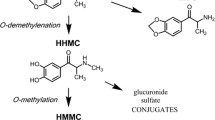Abstract
Oral fluid (OF) offers a noninvasive sample collection for drug testing. However, 3,4-methylenedioxymethamphetamine (MDMA, ecstasy) in OF has not been adequately characterized in comparison to plasma. We administered oral low-dose (1.0 mg/kg) and high-dose (1.6 mg/kg) MDMA to 26 participants and collected simultaneous OF and plasma specimens for up to 143 h after dosing. We compared OF/plasma (OF/P) ratios, time of initial detection (t first), maximal concentrations (C max), time of peak concentrations (t max), time of last detection (t last), clearance, and 3,4-methylenedioxyamphetamine (MDA)-to-MDMA ratios over time. For OF MDMA and MDA, C max was higher, t last was later, and clearance was slower compared to plasma. For OF MDA only, t first was later compared to plasma. Median (range) OF/P ratios were 5.6 (0.1–52.3) for MDMA and 3.7 (0.7–24.3) for MDA. OF and plasma concentrations were weakly but significantly correlated (MDMA: R 2 = 0.438, MDA: R 2 = 0.197, p < 0.0001). Median OF/P ratios were significantly higher following high dose administration: MDMA low = 5.2 (0.1–40.4), high = 6.0 (0.4–52.3, p < 0.05); MDA low = 3.3 (0.7–17.1), high = 4.1 (0.9–24.3, p < 0.001). There was a large inter-subject variation in OF/P ratios. The MDA/MDMA ratios in plasma were higher than those in OF (p < 0.001), and the MDA/MDMA ratios significantly increased over time in OF and plasma. The MDMA and MDA concentrations were higher in OF than in plasma. OF and plasma concentrations were correlated, but large inter-subject variability precludes the estimation of plasma concentrations from OF.

Oral fluid and plasma 3,4-methylenedioxymethamphetamine (MDMA) concentrations in all simultaneously collected paired-positive specimens collected −0.25 to 143 h after 1.0 and 1.6 mg/kg oral MDMA administration to 26 adult participants



Similar content being viewed by others
References
UNODC (United Nations Office on Drugs and Crime) (2011) World Drug Report 2011. Vienna
Lacey JH, Kelley-Baker T, Furr-Holden D, Voas RB, Romano E, Ramirez A, Brainard K, Moore C, Torres P, Berning A (2009) 2007 National Roadside Survey of Alcohol and Drug Use by Drivers: Drug Results. National Highway Traffic Safety Administration Office of Behavioral Safety Research
Drummer OH, Kourtis I, Beyer J, Tayler P, Boorman M, Gerostamoulos D (2012) The prevalence of drugs in injured drivers. For Sci Int 215(1–3):14–17
Barnes AJ, Scheidweiler KB, Kolbrich-Spargo EA, Gorelick DA, Goodwin RS, Huestis MA (2011) MDMA and metabolite disposition in expectorated oral fluid after controlled oral MDMA administration. Ther Drug Monit 33(5):602–608
Kolbrich EA, Goodwin RS, Gorelick DA, Hayes RJ, Stein EA, Huestis MA (2008) Plasma pharmacokinetics of 3,4-methylenedioxymethamphetamine after controlled oral administration to young adults. Ther Drug Monit 30(3):320–332
Samyn N, van Haeren C (2000) On-site testing of saliva and sweat with Drugwipe and determination of concentrations of drugs of abuse in saliva, plasma and urine of suspected users. Int J Legal Med 113:150–154
Samyn N, De Boeck G, Wood M, Lamers CTJ, De Waard D, Brookhuis KA, Verstraete AG, Riedel WJ (2002) Plasma, oral fluid and sweat wipe ecstasy concentrations in controlled and real life conditions. Fors Sci Int 128:90–97
Peters FT, Samyn N, Kraemer T, Riedel WJ, Maurer HH (2007) Negative-ion chemical ionization gas chromatography–mass spectrometry assay for enantioselective measurement of amphetamines in oral fluid: application to a controlled study with MDMA and driving under the influence cases. Clin Chem 53(4):702–710
Navarro M, Pichini S, Farre M, Ortuno J, Roset PN, Segura J, de La Torre R (2001) Usefulness of saliva for measurement of 3,4-methylenedioxymehamphetamine and its metabolites: correlation with plasma drug concentrations and effect of salivary pH. Clin Chem 47:1788–1795
Kolbrich EA, Lowe RH, Huestis MA (2008) Two-dimensional gas chromatography/electron impact-mass spectrometry with cryofocusing for the sensitive, specific and simultaneous quantification of 3,4-methylenedioxymethamphetamine (MDMA, 3,4-methylenedioxyamphetamine (MDA), 4-hydroxy-3-methoxymethamphetamine (HMMA), 4-hydroxy-3-methoxyamphetamine (HMA), and 3,4-methylenedioxyethylamphetamine (MDEA) in human plasma. Clin Chem 54:379–387
Scheidweiler KB, Huestis MA (2006) A validated gas chromatographic-electron impact ionization mass spectrometric method for methylenedioxymethamphetamine (MDMA), methamphetamine and metabolites in oral fluid. J Chromatogr B 835:90–99
Walsh JM, Verstraete AG, Huestis MA, Morland J (2008) Guidelines for research on drugged driving. Addiction 103:1258–1268
Pil K, Raes E, Neste TVd, Verstraete A (2007) Toxicological analyses in the DRUID epidemiological studies: analytical methods, target analytes and analytical cut-offs. Paper presented at the European Integrated Project DRUID 2007
Bush DM (2008) The U.S. Mandatory Guidelines for Federal Workplace Drug Testing Programs: current status and future considerations. For Sci Int 174(2–3):111–119
Garrett ER, Seyda K, Marroum P (1991) High performance liquid chromatographic assays of the illicit designer drug “ecstasy”, a modified amphetamine, with applications to stability, partitioning and plasma protein binding. Acta Pharm Nord 3(1):9–14
Moffat AC, Osselton MD, Widdop B, Galichet LY (2004) Clarke’s analysis of drugs and poisons in pharmaceuticals, body fluids and postmortem material, 3rd edn. Pharmaceutical Press, London
Barfknecht CF, Nichols DE (1975) Correlation of psychotomimetic activity of phenethylamines and amphetamines with 1-octanol–water partition coefficients. J Med Chem 18(2):208–210
Acknowledgments
We acknowledge the contributions of the clinical staffs of the National Institute on Drug Abuse, Intramural Research Program, and Behavioral Pharmacology Research Unit, Johns Hopkins Bayview Medical Center, as well as the Graduate Partnership Program, NIH and the Fondation Baxter et Alma Ricard. This research was funded by the Intramural Research Program, National Institute on Drug Abuse, NIH.
Author information
Authors and Affiliations
Corresponding author
Rights and permissions
About this article
Cite this article
Desrosiers, N.A., Barnes, A.J., Hartman, R.L. et al. Oral fluid and plasma 3,4-methylenedioxymethamphetamine (MDMA) and metabolite correlation after controlled oral MDMA administration. Anal Bioanal Chem 405, 4067–4076 (2013). https://doi.org/10.1007/s00216-013-6848-7
Received:
Revised:
Accepted:
Published:
Issue Date:
DOI: https://doi.org/10.1007/s00216-013-6848-7




